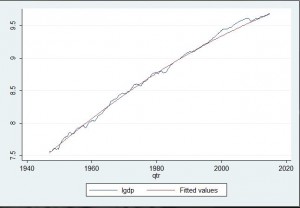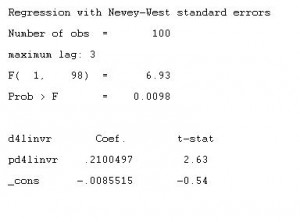I am fairly sure it is a coincidence, but current US GDP is not disappointingly low compared to an almost incredibly crude forecast based on data from before 1990.
This graph (which you have to click more to see) shows the natural log of US real GDP and a quadratic trend estimated using data from before 1990

According to this graph, current GDP is not anomalously low. Rather GDP in the 90s and 00s was anomalously high. I am almost tempted to take it seriously, because, with the benefit of hindsight, it seems that GDP was driven up by the dot.com and housing bubbles during those periods.
If taken literally, the trend implies that GDP growth declines by -0.029 percent per year per year.
I was interested in the extent to which deviations from quadratic trends estimated with pre 1990 data might be useful when forecasting. I don’t have any particular conclusion
Here is a crude regression

linvr is log real investment minus a quadratic trend estimated with pre 1990 data
lconsr is log real consumption minus a quadratic trend estimated with pre 1990 data
the dependent variable d4linvr is linvr minus linvr lagged one year
l4linvr is linvr lagged one year
l8linvr is linvr lagged two years
l4lconsr is lconsr lagged one year
l8lconsr is lconsr lagged two years
The coefficients were estimated with overlapping 4 quarter intervals, so the standard errors were corrected for serial correlation.
Based on this regression it is possible to forecast the change in real investment out of sample giving forecasts pd4linvr .
The regression suggests that investment reverts towards the quadratic trend and also that high growth of consumption is followed by high growth of investment.
Using only post 1990 out of sample data, the forecasts are significantly correlated with actual changes in real investment

Here is the scatter of out of sample forecasts and outcomes

Note that the scales are different.
I don’t think I have to type that I tried this first with the annual change in log GDP as the dependent variable. That gave similar results within the pre 1990 sample, but the out of sample forecast growth rates weren’t singnificantly correlated with the out of sample actual growth rates.













Leave A Comment